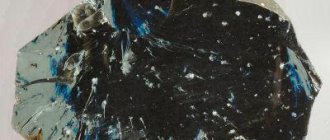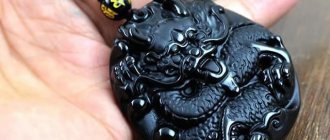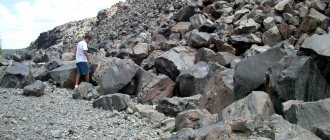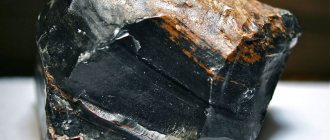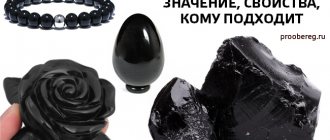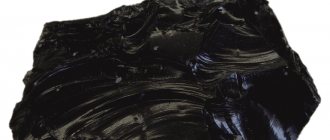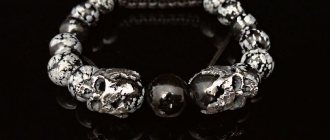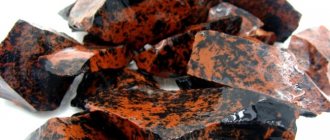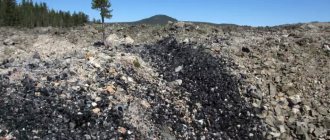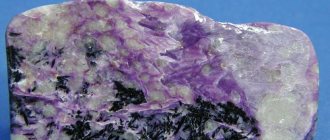When choosing jewelry made from valuable and beautiful stones, it is unlikely that anyone would want to buy a piece of glass or plastic for a decent amount of money. But this is exactly how obsidian is copied. Today you will learn how to distinguish real obsidian from a fake.
The stone is quite common, but at the same time valuable. Jewelry is not the cheapest.
There are several signs by which you can find out how to distinguish real obsidian from a fake.
Colors and types of obsidian
Contrary to popular belief, in nature there are examples of not only black shades. The luxurious mineral boasts a variety of patterns and colors.
It is customary to distinguish 3 main varieties:
- Snow obsidian is the most common. It has a rich black color and small light inclusions of cristobalite crystal. The mineral received such an unusual name due to the shape of the inclusions: they resemble tiny snowflakes.
Snow Obsidian
- Rainbow obsidian amazes with its variety of shades. It is quite rare to find such pebbles, so they are of particular value. In nature you can find reddish, greenish and even blue minerals. In addition to the unusual shade, they are distinguished by an unusual cut, visually reminiscent of a drop of oil.
Obsidian “rainbow”, more than 15 cm. Mexico. Sample: Museum named after. A.E. Fersman. Photo: A.A. Evseev
- Peanut obsidian is quite common. It received this name for its unusual rounded dotted inclusions. Outwardly, they are very similar to peanuts.
Peanut obsidian
The most common color species are:
- Black stone is the most widespread variety; it is the one most often thought of when talking about a mineral. It owes its hue to inclusions of magnetite.
Black obsidian
- Brown obsidian, known as the gem that brings harmony. It also promotes spiritual growth.
Brown obsidian
- Silvery obsidian, which is also called the stone of spirits, shamans and sages.
Silver obsidian
The magical properties of obsidian
Silver Obsidian Ball
Many years ago, people discovered that obsidian has magical properties. He was popular among many peoples of the world. For example, the Indians called obsidian the tears of the Apaches; in Transcaucasia it was called the fragment of Satan's nails. In any case, people believed in his magical powers.
Obsidian was used for various ceremonies and rituals. In the modern world, the stone has not lost its relevance.
Obsidian has the following meaning - it opens the gift of clairvoyance. Therefore, a ball is often made from it, like a crystal ball, which helps to see the future and find answers to questions of interest.
- However, the main meaning of the stone is protection from any negativity. It protects the owner from evil forces and evil witchcraft (evil eye, damage, curses and love spells.).
- Obsidian protects against gossip and bad rumors.
- This stone can be worn even by children. Its positive and soft energy will not harm the child, but will provide powerful protection.
- In addition, obsidian helps to get on the right path and does not allow you to leave it.
- It drives away bad thoughts from a person, thereby preventing him from committing bad deeds.
- In addition, the stone helps a person change his life for the better. Therefore, the mineral may be suitable for those people who need to concentrate on a specific task, for example, scientists and lawyers.
At the same time, the stone is not recommended to be used as an amulet by people of creative professions and people with creative thinking. The fact is that in this case the mineral develops rational thinking and suppresses non-standard thinking. Therefore, the effects of this stone will be detrimental to artistic or creative people.
Origin
Obsidian is an amorphous silicon oxide that forms after the instantaneous cooling of volcanic lava. The magical properties of the stone arose due to its origin.
The mineral was first discovered 9,000 years ago in Mesopotamia. The gem owes its name to the ancient Greek warrior Obsidia. It was he who found obsidian and brought it to Rome. In Transcaucasia they thought that the stone came from the underworld, for which they called it part of Satan’s claw.
In Egypt, obsidian was believed to be the stone of the dead. They placed the mineral next to the deceased person, thereby protecting him in the other world.
Thanks to the cutting edges of obsidian stone, it was used to make knives, scrapers and axes. The ancient American Aztecs made mirrors from the mineral. Many centuries later, it began to be used in jewelry and decorative elements.
Talismans, amulets, amulets
Amulet made of black obsidian
Volcanic glass makes its owner luckier and more attractive in the eyes of others. Interestingly, thanks to the magical properties of obsidian, the owner of the raw mineral or a product made from it also becomes more attentive and sensitive to other people. The stone seems to make it possible to move faster in spiritual development, seek and find inspiration, and receive “flashes” of insight.
According to Eastern beliefs, lava glass reveals to the wearer the secrets of his previous incarnations and helps reduce the severity of karmic “traumas”. Meditation with a stone allows you to quickly overcome existing psychological complexes and mental problems. In a number of countries, magic balls are made from volcanic rock.
Obsidian can be considered a talisman, an amulet, and a talisman. He is able to suppress aggression and relieve tension.
Married couples can wear obsidian wedding rings to maintain fidelity and harmony, romance and passion in family life. If jewelry and objects for rituals belong to psychics and magicians, then it is easier for them to “communicate” with higher powers. Obsidian also helps clairvoyants develop the ability to see the past and future.
Healing properties
Peanut obsidian pendant
In lithotherapy manuals published in different countries, obsidian is mentioned as one of the most important healing stones among more than 400 rocks and minerals. Reviews are devoted to the influence of physical and chemical characteristics, origin on the therapeutic effect, and significance for the signs of the Zodiac. Modern lithotherapists claim that obsidian can alleviate the course of diseases and speed up recovery.
The value of the stone for health:
- has a beneficial effect on the functioning of the gastrointestinal tract and liver;
- stabilizes blood pressure and kidney function;
- used in hematology, for long-term non-healing wounds;
- helps improve metabolism and strengthen the immune system;
- used for nervous disorders and increased anxiety.
Thanks to the therapeutic effect of the stone, erosions and ulcers heal faster and the absorption of nutrients improves. When wearing an obsidian bracelet on the left hand, vascular tone and blood pressure are normalized. The energy of volcanic glass helps restore the body after heart attacks and strokes.
Obsidian can be used for deep emotional upheavals and experiences that cause emotional pain. The stone gives strength and supports in confronting troubles. It also helps to find resources for an active life in one’s own body, and helps to learn useful lessons from traumatic situations.
Black volcanic glass helps to get rid of various phobias. Helps to cope with past negative experiences and associated mental and physical pain. Internal unused reserves are revealed and perception increases.
Important!
It should be noted that the information about the healing properties of stones given in reference books and encyclopedias on lithotherapy is based on folklore sources and publications on traditional medicine of past centuries. Information about the healing effects of rocks and minerals has not been tested in clinical studies. This is the result of centuries-old observations and application experience.
Physicochemical characteristics
Unlike rauchtopaz and morion, obsidian has an amorphous structure. The stripes on the samples show the direction of lava movement. The composition of the gem is oxidized silicon. Transparent obsidian does not exist in nature; sometimes only the thinnest plates are found.
| Property | Characteristic |
| Traditional name | Volcanic glass |
| Chemical formula | SiO2; MgO, Fe3O4 |
| Coloring | Black, reddish, gray, brown |
| singonia | Amorphous |
| Kink | Conchoidal |
| Texture | Foamy, massive |
| Shine | Glass |
| Mass of one mole | 231.5333 g/mol |
| Density | 2.5 g/cm³ |
| Mohs hardness | 5,0-6,0 |
The mineral is fragile, so it must be handled responsibly. It must be protected from mechanical stress and heat. It is easy to polish and looks like glass.
Areas of application
Obsidian tools from Tilkitepe, Turkey, 5th millennium BC.
e. The use of the mineral is possible in various fields. However, most often it is used as an ornamental stone. Before starting to create beautiful products, the mineral is carefully polished. It acquires a smooth surface and a special shine.
The stone is often used to create inexpensive jewelry. Obsidian earrings, bracelets and beads are perfect for daily wear. They are especially suitable for dark-eyed brunettes and emphasize the natural beauty of their owner.
Black glass is also used to create interior items: bowls, glasses, vases. Obsidian rosary beads look unusual.
This amazing mineral is incredibly popular in the fields of jewelry and applied arts. Works by famous sculptors and jewelers, which contain elements of volcanic glass, can still be found in various museums around the world. Carl Faberge especially appreciated the unique properties of obsidian. He used the mineral in his works, which are now famous throughout the world.
The main area of application for obsidian is construction. It is from obsidian that perlite is obtained, a building material with excellent thermal insulation properties.
Due to the ability of obsidian powder mixed with slaked lime to harden under water, it is used as a hydraulic additive for Portland cement. It is also used as an additive to lime, as a raw material for the production of dark glass and as thermal insulation.
Obsidian blades have a smooth edge just a few nanometers thick, allowing them to be used as scalpels.
Medicinal properties
Obsidian, like all stones, has a number of healing properties. In alternative medicine, the mineral acts as follows:
- Treats colds.
- Relieves ailments from hypothermia.
- Improves the condition of the gastrointestinal tract.
- Normalizes blood pressure.
- Promotes recovery from diseases of the spine and rheumatism.
- Solves problems of the genitourinary system.
- Eliminates nervousness.
People with kidney disease should treat the mineral with caution. This interaction disrupts the energy balance, which means a disruption in the functions of the organ.
The stone is used for medicinal purposes as a material for making instruments in surgery. It was noticed that after exposure of the body to such objects, cut sites heal faster.
Obsidian products and jewelry
Obsidian bracelet
Decorative items made from volcanic glass always look noble and a little solemn. The stone is highly polished. Boxes, photo frames, vases will add a touch of aristocracy to the interior of the house. An obsidian souvenir - what could be better as a gift for a loved one.
Bracelets, beads, rings, and earrings are also made from obsidian. Due to its original appearance, the stone matches clothes of any color, both bright and plain.
The cost of obsidian depends on several factors:
- stone colors;
- its size;
- cutting;
- forms;
- processing difficulties.
The price for 1 gram of obsidian is low, it starts from $1. But there is a rarest type of stone - green obsidian, the cost of which is higher than that of a diamond.
Approximate cost of volcanic glass products:
- Beads - from $20.
- Earrings, rings - $40.
- Bracelets - $15.
- Pendants, amulets - $2.
- Small spheres, figurines - $20.
Appearance
Now let's talk about obsidian stone - how to distinguish a fake, and also what you need to pay attention to.
To recognize a deception, it is necessary to understand all the characteristic features of a genuine stone.
Obsidian stone or volcanic glass has several characteristic features in appearance:
- the base of the product is petrified lava;
- natural material is not characterized by high strength;
- at the same time, it has a bright shine;
- the stone is quite fragile in structure, but dense;
- mostly translucent, but sometimes transparent;
- The color range of this mineral is dark;
- Mostly stones are found in black, brown, and gray tones;
- the undertone is red or green;
- natural origin allows you to see formed patterns in the form of stripes, spots, and smudges;
- this is caused by influxes of solidifying lava.
The dark tones are due to the fact that the mineral contains magnetin.
It is natural impurities, which can be different, that affect the undertone.
Its popularity among jewelers is due to the fact that after polishing the mineral acquires a smooth structure and also acquires a golden, silver or pearlescent sheen.
How to recognize a fake
Decoration made from obsidian
Obsidian is one of the inexpensive ornamental stones. Despite this, there are craftsmen who try to imitate it. In trade, the mineral is often replaced with painted glass. There are several ways to distinguish real jewelry from a fake:
- The first thing to do is to carefully examine the beads, bracelet, rosary or any other product. Natural material has a bright, rich color and shine.
- Real stones are able to maintain temperature for a long time. To check, you need to hold the stone in your hand for a few minutes. If after this it remains cold, then it is not a fake.
- Obsidian, the color of which is uniform and uniform, is most likely fake. Real minerals have numerous inclusions and intricate patterns.
- If possible, you should briefly immerse the stone in clean water. The fake will quickly lose its original appearance. The attractive shine will disappear and the shade will change.
Knowing these simple rules and the properties of stones, you can quickly understand whether this is an original or a fake.
How to distinguish a fake?
When purchasing, it is important to pay attention to the authenticity of the stone, since they often try to pass it off as painted glass, the true price of which is much lower. The following features will help distinguish the original from an artificial mineral:
- Natural stone has a shiny surface and rich color.
- A real stone is cold to the touch and needs to be held in your hands for a long time to heat it up.
- It is rare to find a single-colored gem, since obsidian has a lot of inclusions of different shapes and shades.
- The easiest way to distinguish a fake is with the help of water: if a stone, after immersion in liquid, loses its shine and becomes faded, then it is ordinary glass.
Knowing the properties of obsidian, it will be impossible to purchase a fake mineral. Before purchasing, it is recommended to study all the information about the gem.
Obsidian can be a talisman, a stylish decoration, an astrological symbol and an ornamental material. The mineral will help almost all people who want to solve problems with the help of its volcanic energy.
How to properly care for stone
Obsidian jewelry
Do not forget that this material is glass, albeit volcanic. Obsidian jewelry requires careful, careful care. There are several rules that are best followed to ensure that the stone lasts a long time.
- You should not keep the gem in the same box with other jewelry. It is best to store it in a separate case, lined with soft fabric.
- When exposed to direct sunlight, the stone loses its rich obsidian color. Therefore, you should not wear it too often. At least don't wear it in plain sight.
- Protect your earrings, rings, and beads from bumps and falls. The gem not only breaks into pieces - its fragments are very sharp and dangerous to collect.
- The mineral loses its color characteristics if it sits in water for a long time, as well as under the influence of chemical reagents. Remove your jewelry when cleaning or even just washing dishes.
- The crystal needs to be cleaned from time to time. To do this, rinse it with cold water, then wipe dry with a soft cloth or sanitary napkin. The mineral should not be wet, otherwise its color and structure may be damaged.
Processing Features
See also
How to distinguish a real dollar from a fake: 6 ways
Another option for distinguishing real obsidian from a fake is to look at the processing features of the jewelry.
The stone is quite soft, which is why it cannot be processed into complex cuts.
If you come across an obsidian product with a complex shape, you can probably say that it is a fake.
The mineral can be ground well and also polished. This allows you to level the surface. Natural uneven shapes are eliminated and shine is further enhanced.
Cutting is another popular way to process stone. This is due to the same softness of the natural mineral.
But it is not customary to refine obsidian. Also, impregnation, oiling, or irradiation are not used.
Occasionally, craftsmen discolor the material. This allows you to obtain the so-called Nevada diamond.
Discolored obsidian can be passed off as a gemstone. Although in practice this does not happen so often. It's too easy to spot a fake.
Which stones go with?
Ring with obsidian
Combining stones is a whole science. It is known for certain that the best combinations are made of minerals belonging to the same element. Also, according to astrologers, one should not neglect the connection of stones with the signs of the zodiac and the planets that protect them. If the stones are not aligned correctly, then at best they will cancel each other out, and at worst they will create negative vibrations.
The mineral obsidian belongs to the element of Earth. His friends":
- agate;
- nephritis;
- turquoise;
- crocodile;
- onyx;
- malachite;
- emerald;
- aventurine;
- jasper;
- amber;
- jet.
Pendant with obsidian
Of its group of Earth stones, obsidian is unique in that it “feels” well next to Fire minerals. This is due to the origin of the stone - it was born from fire. It will make a good pair:
- with pomegranate;
- topaz;
- tiger eye;
- carnelian;
- red agate;
- hematitis;
- red tourmaline;
- diamond.
Obsidian goes well with rock crystal. Their duet is most often used in meditation for enhanced cleansing and charging of the sex chakra. Together they are able to level out a person’s energy.
Whose horoscope suits obsidian?
According to astrologers, wearing obsidian is not suitable for all zodiac signs. For some of them it is even contraindicated.
Obsidian compatibility chart with zodiac signs:
| Zodiac sign | Compatibility (“+++” is ideal, “+” is good, “-” is bad) |
| Aries | + |
| Taurus | + |
| Twins | + |
| Cancer | – |
| a lion | + |
| Virgo | – |
| Scales | + |
| Scorpion | + |
| Sagittarius | + |
| Capricorn | +++ |
| Aquarius | + |
| Fish | + |
